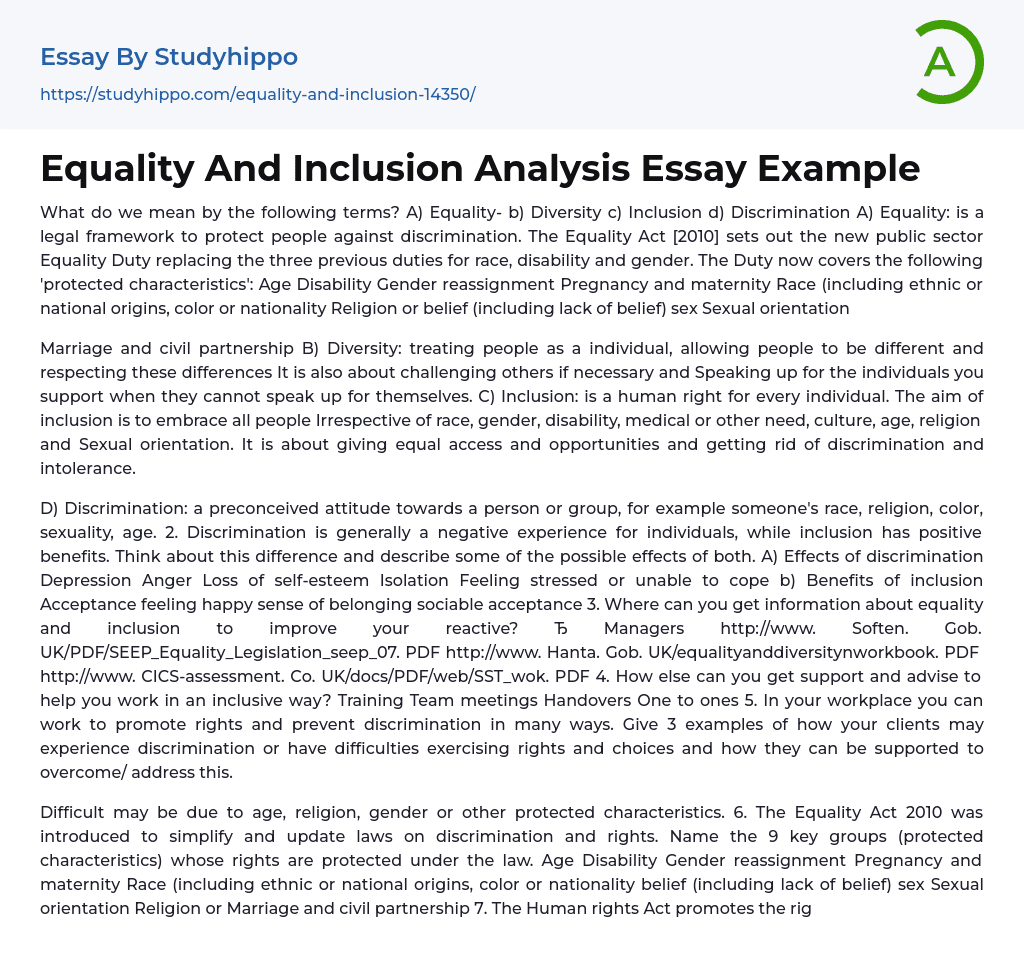The terms explained in this text are:
A) The Equality Act [2010] is a legal framework that protects individuals from discrimination. It replaces previous obligations for race, disability, and gender with the new public sector Equality Duty. This Duty now covers various 'protected characteristics' including age, disability, gender reassignment, pregnancy and maternity, race (including ethnic or national origins, color or nationality), religion or belief (including lack of belief), sex, and sexual orientation. It also includes marriage and civil partnership.
B) Diversity involves treating individuals as unique beings and respecting their differences. It entails accepting and celebrating diversity while advocating for those who cannot speak up for themselves when necessary.
C) Inclusion is a fundamental right for all individuals. Its objective is to embrace every person regardless of their race, gender, disability, medical or other needs, culture, age, religion or sexual orientation. Inclusion focuses on providing equal a
...ccess and opportunities while eliminating discrimination and intolerance.
Discrimination involves biased attitudes towards individuals or groups due to factors like race, religion, color, sexuality, and age. It can lead to negative consequences such as depression, anger, low self-esteem, isolation, and stress. On the other hand, inclusion brings numerous positive benefits including acceptance, happiness, a sense of belongingness, and sociability.
Managers have the ability to offer workplace resources on equality and inclusion through different links: - http://www.Soften.Gob.UK/PDF/SEEP_Equality_Legislation_seep_07.PDF - http://www.Hanta.Gob.UK/equalityanddiversitynworkbook.PDF - http://www.CICS-assessment.Co.UK/docs/PDF/web/SST_wok.PDF In order to receive support and guidance for inclusive work practices; one can participate in training sessions or engage in team meetings,hands-overs,and one-to-one meetings.
Efforts should be made within the workplace to promote rights and prevent discrimination. Clients may face discrimination or encounter obstacles when exercising their rights based on characteristic
protected by the Equality Act 2010 such as age, religion, gender etc. Support can be provided to help overcome/address these difficulties.The Equality Act 2010 simplifies and updates laws on discrimination and protects the rights of nine key groups, including Age, Disability, Gender reassignment, Pregnancy and maternity, Race (including ethnic or national origins), color or nationality), Belief (including lack of belief), Sex, Sexual orientation Religion or Marriage and civil partnership. The Human Rights Act advocates for individuals' rights in various aspects of life through articles such as Article 2 - Right to life;Article 3 - Prohibition of torture;Article 4 - Prohibition of slavery and forced labor;Article 5 - Right to liberty and security;Article 6 - Right to a fair trial;Article 7 - No punishment without law;Article 8 - Right to respect for private and family life;Article 9 - Freedom of thought, conscience and religion;Article 10 - Freedom of expression;Article 11 - Freedom of assembly and association;Article 12 - Right to marry;and Article 14 - Prohibition of discrimination. The General Social Care Council's Code of Practice provides guidance on equality and diversity responsibilities for care workers and employers. These codes establish standards that must be followed in social work practice, playing a crucial role in regulating the workforce while enhancing professionalism and protecting the public. To gain a better understanding of how equality is practiced and promoted in your workplace, it is recommended that you consult the workplace policy on equality.The following text provides guidelines and principles for promoting equality and inclusion in CSS services. CSS is dedicated to ensuring equal opportunities for individuals, regardless of disability, race, color, ethnic or national origin, class, appearance, religion or
belief, HIV/AIDS status, age or perceived age, gender identity or expression (including transgender status), marital or civil partnership status. Additionally, CSS recognizes the responsibilities of part-time or shift workers who have dependents unrelated to criminal activities and sexual orientation. CSS is committed to ethically opposing any actions that hinder equality and strives to raise awareness about legal obligations set forth in Acts of Parliament and Employment Regulations.
- Values of Life essays
- Ethical dilemma essays
- Normative Ethics essays
- Virtue Ethics essays
- Belief essays
- Deontology essays
- Moral essays
- Virtue essays
- Work Ethic essays
- Ageism essays
- Cultural Diversity essays
- Discrimination essays
- Diversity essays
- Gender Discrimination essays
- Multiculturalism essays
- Oppression essays
- Peer Pressure essays
- Racial Profiling essays
- Sexism essays
- Equality essays
- Gender equality essays
- Gender Inequality essays
- Minority essays
- Segregation essays
- Social Inequality essays
- Acceptance essays
- Age Of Enlightenment essays
- Child Observation essays
- Confucianism essays
- Conscience essays
- Critical Reflection essays
- Destiny essays
- Determinism essays
- Empiricism essays
- Environmentalism essays
- Epistemology essays
- Ethics essays
- Ethos essays
- Existence essays
- Existentialism essays
- Fate essays
- Free Will essays
- Functionalism essays
- Future essays
- Good And Evil essays
- Human Nature essays
- Individualism essays
- Meaning Of Life essays
- Metaphysics essays
- Natural Law essays




